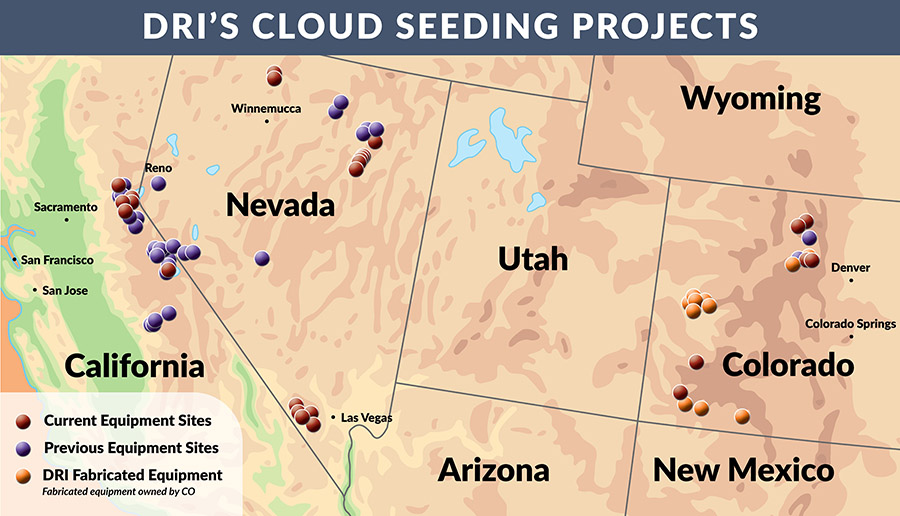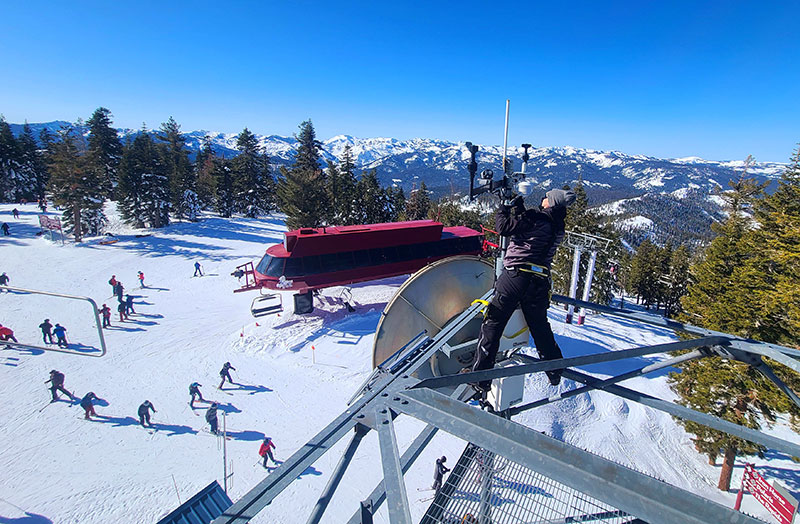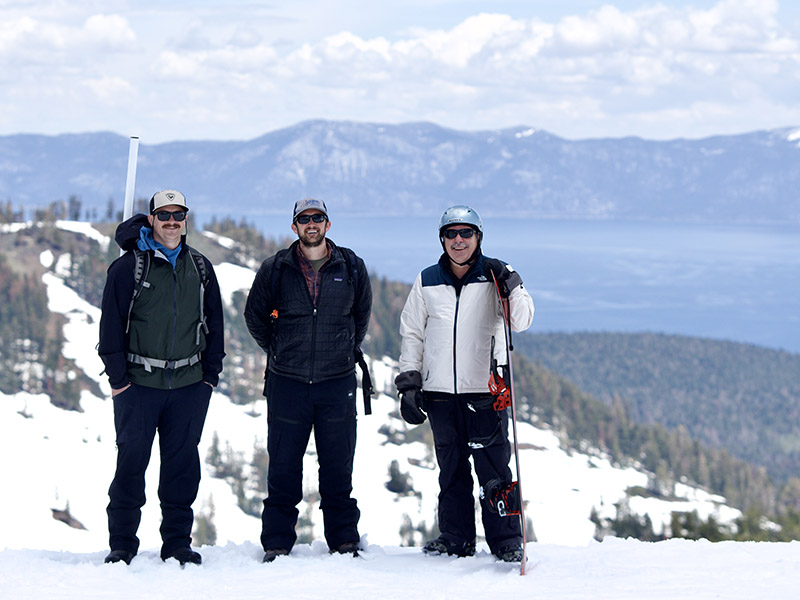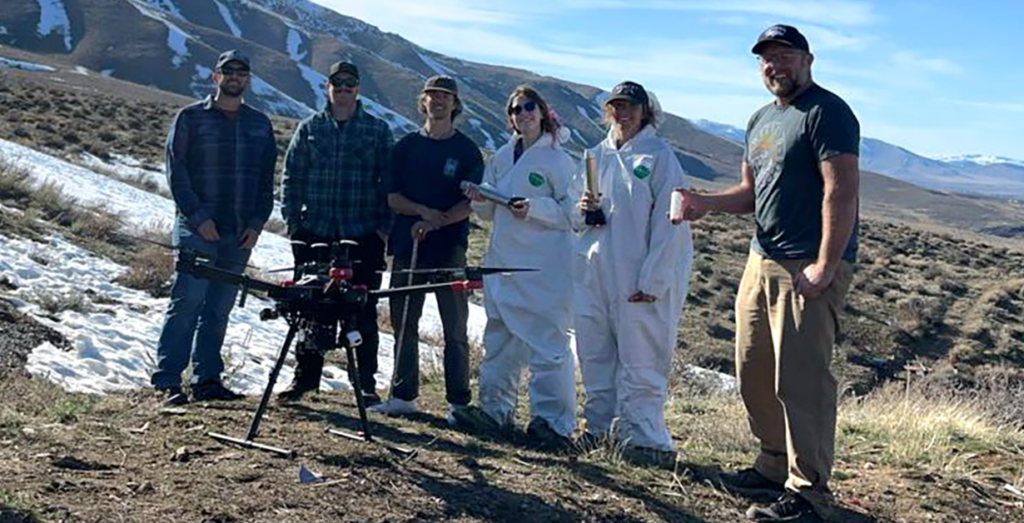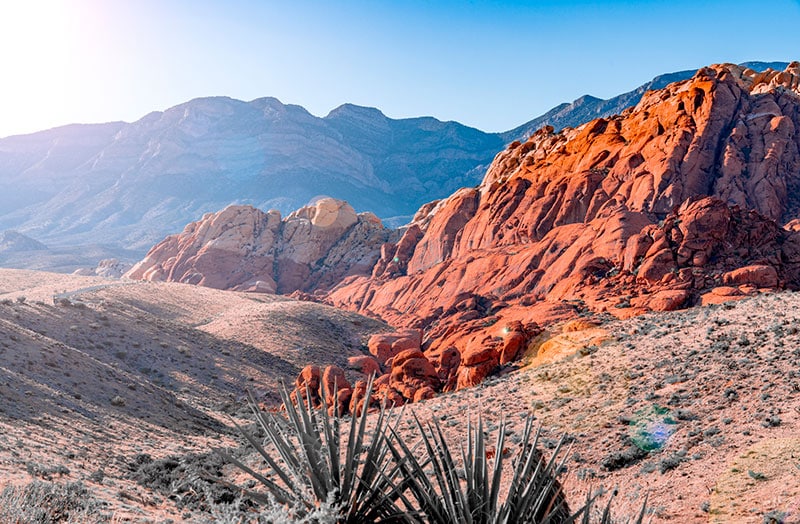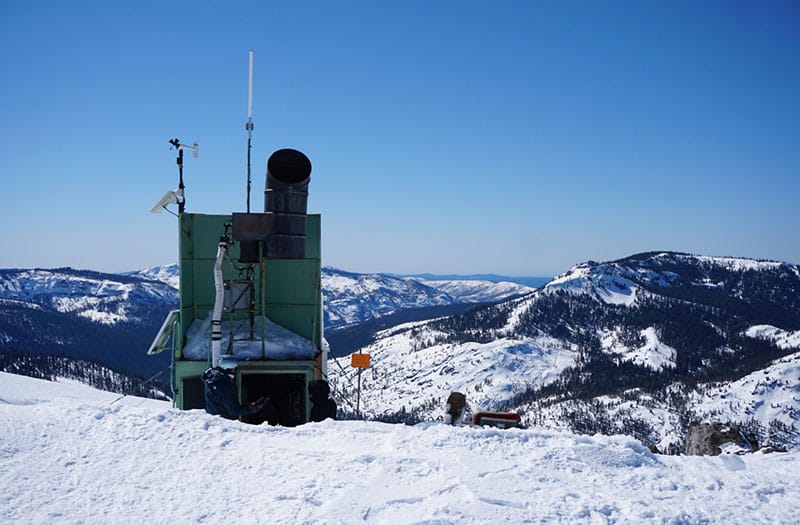CLOUD SEEDING PROGRAM
Frank McDonough, M.S. | Program Director
During the early 1960s, scientists from DRI helped to pioneer the science of wintertime cloud seeding, developing research-based methods for increasing winter snowpack and subsequent snowmelt runoff across mountainous regions of the Western US. Since the DRI Cloud Seeding Research Program’s early days, our team of experts has conducted continuous research and development to create time-tested cloud seeding methods that are proven to enhance snowfall from winter storms. DRI’s cloud seeding projects are conducted in an environmentally safe manner, increasing the precipitation formation efficiencies of passing clouds to support the water needs of local communities and ecosystems.
DRI’s team of scientists and technicians work year-round to design, maintain, and operate successful cloud seeding projects for state, local, and federal partner agencies. During the winter season (November – May), DRI will conduct cloud seeding research and operations in six mountain ranges including the Lake Tahoe Basin (CA/NV), Spring Mountains (NV), Ruby Mountains (NV), Santa Rosa Mountains (NV), the San Juan Mountains (CO), and in the Upper Colorado River Headwaters region along the Continental Divide in northern Colorado. DRI cloud seeding generators will also be operated over the Grand Mesa in western Colorado.
Note: DRI’s support of Colorado Water Commission Board (CWCB) projects are not funded by the state of Nevada, however the additional precipitation added to the Colorado River watershed directly benefits Southern Nevada water/power resource users.
In addition to designing and conducting cloud seeding projects for specific partner agencies, DRI’s team monitors the results of cloud seeding operations via a network of precipitation stations. The team is also actively involved in subfreezing cloud physics research, including studies of clouds that cause icing on aircraft, and the effects of air pollution on clouds structures and storms.
Making it Snow: A Brief History and Review of the Science Behind Cloud-Seeding
Scientists can now regularly harness cloud moisture and pull it to Earth, bringing water to parched communities and landscapes around the world.
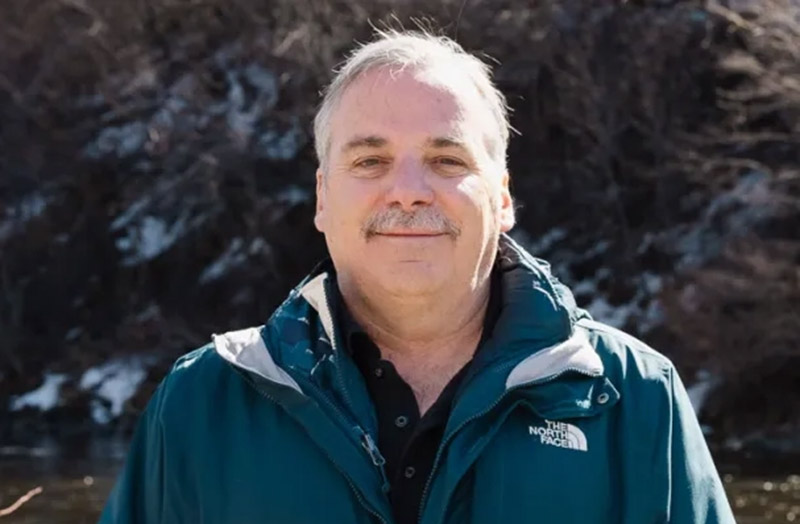
Job title of the future: Weather maker
Frank McDonough was featured in MIT Technology Review. Read the full article on their website.
Frequently Asked Questions:
1. Is cloud-seeding producing so-called “chem-trails”?
No. Those fluffy white lines zig-zagging across the sky are jet contrails, and they are the aviation equivalent of visible plumes of steamy breath on a cold morning. Warm water vapor produced during jet fuel combustion interacts with the cold atmospheric air to create strings of ice crystals that behave like high-altitude cirrus clouds. When a plane passes through an area of high pressure, which leads to low winds and clear skies, the trails will linger. Jet contrails have no connection with cloud-seeding activities, and all of DRI’s cloud-seeding occurs from ground generators, not planes.
2. Is cloud-seeding “geoengineering”?
Cloud-seeding is a well-researched and monitored form of small-scale weather enhancement. Other examples of ways that humans change the weather and the global climate include: driving a car, deforestation, and air pollution from industry.
3. Who is funding cloud-seeding programs?
Cloud-seeding programs occur worldwide. In the Western U.S., state and agency-supported efforts occur across California, Nevada, Colorado, New Mexico, Wyoming, Kansas, Oklahoma, Texas, North Dakota, Utah, and Idaho.
4. Is silver iodide toxic?
No. The silver used in cloud-seeding is silver iodide (AgI, or silver bonded to iodine), which can be confused with other molecular forms of silver. When silver is isolated as an ion (Ag+) it is biologically active, meaning it interacts with bacterial or fungal cell walls — which is why it’s often used for medicinal purposes and for sterilizing drinking water. Silver ion (Ag+) can be hazardous in aquatic environments because it can also interact with proteins and other parts of cell membranes, but silver iodide (AgI), not silver ion (Ag+), is used for seeding clouds. Silver iodide retains its form in water and does not break down into the potentially toxic silver ion. When the silver iodide particle falls to the ground with rain or snow, it separates from the water molecules that formed an ice crystal around it, essentially becoming a speck of dust no different from the silver naturally occurring in the soil.
Although the chemistry can be a bit complicated, you can think of it as the difference between water (H2O) – the life-giving force that forms much of your own body – and hydrogen peroxide (H2O2), which is used as a sterilizer and bleaching agent and is hazardous at high concentrations .
5. Is cloud-seeding used for military purposes?
Following the (now declassified) use of cloud-seeding by the U.S. military during the Vietnam War, a 1977 international treaty banned the use of weather modification in warfare.
6. Does DRI continue cloud-seeding during intense winters like the winter of 2022-2023?
DRI pauses all cloud-seeding activities when the snowpack reaches 150% of the historical average. In the Lake Tahoe region, this means that cloud-seeding activities halted in mid-December, 2022, due to the remarkable amount of natural snowfall occurring.
7. Does cloud-seeding have any impact on climate change?
No. DRI’s cloud-seeding program supplements the precipitation in existing storms, which can help alleviate the impacts of drought in targeted areas. It has no impact on the growing amount of greenhouse gases in the atmosphere—these are the direct result of burning fossil fuels to power cars, planes, and power plants.
8. Can cloud-seeding be used to fight wildfires?
Cloud-seeding can only be used to supplement the precipitation in an existing storm. It can’t be used when there are no storm clouds to squeeze additional moisture from, making it impossible to use to fight wildfires that occur during extremely dry conditions. It can, however, be used to alleviate drought conditions, which can help mitigate wildfire risk.
RELATED STORIES
More information:
Why Cloud Seeding Cannot Make or Control the Weather
ABC News
Where to find more water: eight unconventional resources to tap
The Conversation
By Manzoor Qadir and Vladimir Smakhtin, Deputy Director and Director of the United Nations Institute for Water, Environment, and Health
Can cloud seeding help quench the thirst of the U.S. West?
Yale e360
Wintertime Orographic Cloud Seeding—A Review
Journal of Applied Meteorology and Climatology, Vol. 58, No. 10 (October 2019), pp. 2117-2140
Quantifying snowfall from orographic cloud-seeding
PNAS, Vol. 117, No. 10 (February 2020), pp. 5190-5195
Does cloud seeding really work? An experiment above Idaho suggests humans can turbocharge snowfall
Science Magazine
